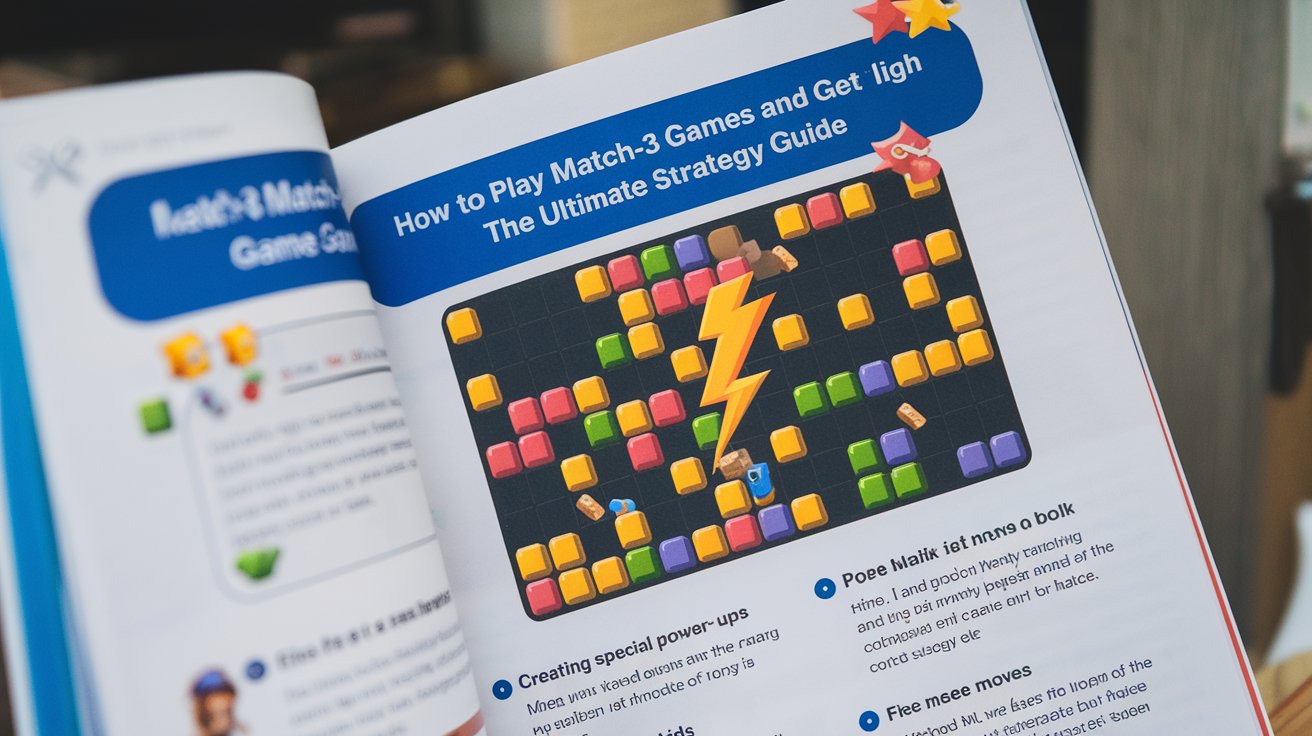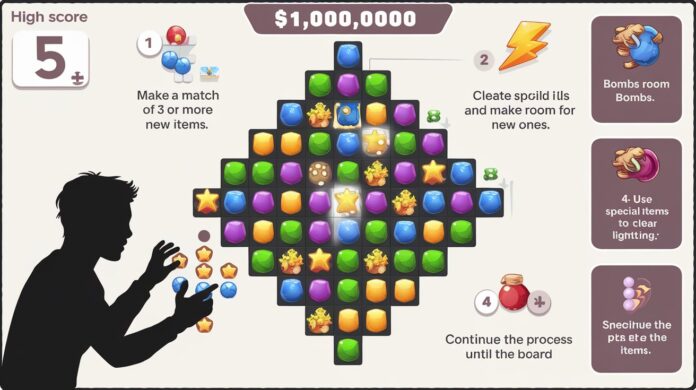The Addictive World of Match-3 Games
If you’ve ever found yourself saying “just one more level” at 2 AM, chances are you’ve fallen under the spell of a Match-3 game. From the iconic Bejeweled that pioneered the genre to modern sensations like Candy Crush Saga, Homescapes, and Gardenscapes, these deceptively simple puzzlers have captivated billions of players worldwide.
The premise seems straightforward—match three or more identical items in a row or column to clear them from the board. Yet beneath this accessible exterior lies a world of strategic depth, careful planning, and split-second decision making that separates casual players from high-score champions.
Whether you’re looking to climb leaderboards, conquer challenging levels, or simply improve your skills, this comprehensive guide will equip you with the knowledge and techniques to transform your Match-3 gameplay from frustrating to fantastic. Get ready to boost your scores, impress your friends, and master the colorful, cascading world of Match-3 games!
Understanding Match-3 Fundamentals
The Basic Mechanics
Before diving into advanced strategies, let’s ensure we’re clear on the fundamentals that unite most Match-3 games:
- The Grid: Typically a square or rectangular array filled with different colored pieces (gems, candies, fruits, etc.)
- Making Matches: Swapping adjacent pieces to create a row or column of three or more identical items
- Clearing the Board: Matched items disappear, causing pieces above to fall down and fill the gaps
- Cascades/Chain Reactions: When falling pieces create new matches automatically
- Level Objectives: Could be score-based, collection-based (gather X number of specific pieces), or obstacle-clearing
While these core mechanics remain consistent, each game adds its own unique twists—special power-ups, limited moves, timer constraints, and distinctive obstacles that create the genre’s endless variety.
Getting to Know Your Game
Every Match-3 title has its own specific features and quirks. Before developing advanced strategies:
- Play the tutorial: Even if you’re a Match-3 veteran, each game has unique mechanics worth learning
- Study the power-ups: Understanding exactly how special pieces work in your specific game is crucial
- Learn level types: Most games alternate between different objectives—familiarize yourself with each
- Identify special challenges: Some levels feature unique obstacles like jellies, locks, or blockers
Strategic Fundamentals: Thinking Beyond the Match

Planning Multiple Moves Ahead
The difference between average players and high-scorers often comes down to foresight:
- Scan the entire board: Don’t just focus on the first match you see
- Visualize the aftermath: Consider how pieces will fall after your move
- Set up cascades: Position pieces to create chain reactions where one match triggers another
- Create opportunities: Sometimes it’s better to make a less obvious match that sets up a more valuable move later
Working From the Bottom Up
One of the most fundamental strategies in Match-3 games is focusing on the lower portion of the board:
- Bottom matches cause larger cascades: When you clear pieces at the bottom, more pieces fall, creating more potential matches
- Create stability: Making matches at the top often leads to unpredictable board states that can disrupt your planning
- Maximize gravity effects: Some games have special mechanics tied to how pieces fall—working from the bottom leverages these more effectively
This approach is particularly effective in games like Candy Crush and Homescapes where cascading matches can dramatically increase your score multiplier.
Mastering Special Pieces and Power-Ups
Creating Special Pieces
Almost every Match-3 game rewards players for matching more than the minimum three pieces:
- Match 4 in a line: Usually creates a striped piece that clears an entire row or column when matched
- Match 5 in a line: Often produces a powerful special piece that can clear multiple pieces or an entire color
- T or L shapes: Many games reward these shaped matches with pieces that clear in specific patterns
- Match 4 in a square: Some games offer unique power-ups for 2×2 square matches
Learning exactly how to create each special piece—and more importantly, when to create them—is essential for maximizing your effectiveness.
Combining Special Pieces
Where the true magic happens is when you match special pieces with each other:
- Special + Special: Combining two special pieces often creates explosive effects that clear large portions of the board
- Special + Same Color: Matching a special piece with regular pieces of the same color frequently enhances its effect
- Special + Booster: Most games offer pre-match boosters that can be strategically combined with special pieces during gameplay
Strategy Spotlight: In games like Candy Crush, combining a color bomb with a striped candy clears all pieces of the striped candy’s color in rows and columns—one of the most powerful combinations available.
When to Use Power-Ups
Knowing when to deploy your hard-earned power-ups is as important as creating them:
- Save for objectives: Hold special pieces for level-specific goals rather than using them immediately
- Break through obstacles: Use them to target stubborn blockers or hard-to-reach areas
- Create cascade opportunities: Deploy them where they’ll trigger the maximum possible chain reaction
- Emergency situations: Save some power-ups for when you’re down to your last few moves
Remember that power-ups are resources—spend them wisely!
Level-Specific Strategies
Score-Based Levels
When your objective is to reach a certain score:
- Prioritize cascades: Chain reactions multiply your points exponentially
- Create and combine special pieces: These generate substantially more points than basic matches
- Target blockers early: Removing obstacles opens up the board for bigger combos later
- Use score multipliers: Some games offer temporary multipliers—maximize your big moves during these periods
Collection Levels
When gathering specific pieces:
- Focus matches around target colors: Make moves that will potentially bring more of your target pieces into play
- Use special pieces strategically: Line up special effects to collect multiple target pieces simultaneously
- Clear paths to targets: If target pieces are trapped behind obstacles, prioritize clearing those obstacles
- Be patient: Sometimes waiting a few moves to set up a perfect collection opportunity is better than making immediate small collections
Obstacle-Clearing Levels
For jelly, cookie, or other obstacle challenges:
- Map your obstacles: Mentally note where all obstacles are located
- Target hard-to-reach corners: Corner obstacles are typically the most challenging—address them early
- Position special pieces strategically: Place them where they’ll affect the most obstacles
- Use special piece combinations: For stubborn obstacles, combined special pieces may be necessary
Advanced Tactics for Expert Players
Board Reading and Pattern Recognition
Elite Match-3 players develop an ability to:
- Spot potential special piece creations: Quickly identify where you’re one move away from creating powerful pieces
- Recognize cascade opportunities: See where moving one piece might trigger a chain of reactions
- Identify “dead zones”: Areas of the board where moves won’t contribute to your objectives
- Predict board evolution: Anticipate how the board will look 2-3 moves ahead
This skill develops with practice—the more you play mindfully (rather than just making the first match you see), the better you’ll become at reading the board.
Managing Randomness
Match-3 games involve an element of luck as new pieces enter the board randomly. Expert players:
- Create contingency plans: Have alternative strategies ready when random elements disrupt your main plan
- Maximize controllable areas: Focus on parts of the board where you have more predictability
- Leverage randomness: Sometimes clearing a large area and letting random new pieces fall can create unexpected opportunities
- Reset problematic boards: In games that allow restarting without penalty, recognize when a board layout is unfavorable
Managing Resources and Currencies
Most modern Match-3 games include in-game currencies and limited resources:
- Save boosters for truly difficult levels: Don’t waste them on levels you could beat with a few more attempts
- Complete daily challenges: These often reward currencies or power-ups
- Plan your playing sessions: Many games offer free lives or boosters at specific intervals
- Participate in events: Special events frequently offer better rewards than regular gameplay
Game-Specific Insights
Candy Crush Saga and Variants
- Color bomb + striped candy: This powerful combination clears all candies of one color in rows and columns
- Wrapped candy combinations: Creating and combining wrapped candies creates massive explosions
- Chocolate management: In levels with spreading chocolate, prioritize containing it early
Bejeweled Series
- Hypercube strategy: Creating these special pieces (match 5) can clear entire colors
- Time-based modes: Focus on quick matches rather than setting up elaborate combinations
- Flame gems: Position these for maximum impact on surrounding gems
Homescapes/Gardenscapes
- Rocket power-ups: These clear entire rows or columns—aim them at critical objectives
- Bomb power-ups: Have a 3×3 blast radius—position them where they’ll affect the most obstacles
- Rainbow balls: Can clear all pieces of a chosen type—save them for difficult-to-reach objectives
Overcoming Common Challenges
Dealing with Difficult Levels
Every player eventually hits a wall with challenging levels:
- Step away temporarily: A fresh perspective often helps solve seemingly impossible boards
- Watch expert playthroughs: Many YouTubers share strategies for notorious levels
- Analyze your failures: Determine if you’re approaching the level’s objective incorrectly
- Start with different moves: The initial moves often determine the board’s evolution—try various opening strategies
Breaking Through Score Plateaus
If your scores seem to be stagnating:
- Focus on creating more special pieces: Regular matches rarely lead to top scores
- Prioritize combinations: Special piece combinations multiply your scoring potential
- Improve your cascade recognition: Look for moves that will trigger multiple subsequent matches
- Record and analyze your gameplay: Reviewing your approach can reveal missed opportunities
Managing Timed Challenges
For levels with time constraints:
- Scan for quick matches: Speed becomes more important than elaborate setups
- Prioritize time boosters: Some games offer power-ups that add seconds to your timer
- Focus on cascade opportunities: One good cascade can accomplish more than several individual matches
- Practice rapid pattern recognition: Train yourself to spot matches quickly without sacrificing strategic thinking
The Psychology of Match-3 Success
Maintaining Focus
Mental stamina is crucial for consistent high scores:
- Take regular breaks: Decision fatigue can impair your performance
- Play in a distraction-free environment: These games require more concentration than they might seem
- Stay positive: Frustration leads to hasty, suboptimal moves
- Set realistic session goals: “I’ll play until I pass five levels” rather than playing indefinitely
Learning From Failures
Every failed level contains valuable lessons:
- Review what went wrong: Was it strategy, execution, or bad luck?
- Identify critical mistakes: Often one wrong move cascaded into level failure
- Adjust your approach: Develop alternative strategies based on what didn’t work
- Recognize pattern traps: Some board layouts trick players into making tempting but strategically poor moves
Conclusion: From Casual Player to Match-3 Master
Match-3 games strike that perfect balance—easy to learn, difficult to master. The journey from casually swiping colorful objects to strategically orchestrating spectacular cascades and combinations is both satisfying and addictive.
Remember that true mastery comes through mindful play. Rather than mindlessly matching whatever’s available, approach each level with purpose. Ask yourself what the objective requires, scan the board for opportunities, plan multiple moves ahead, and position special pieces with intention.
Whether you’re playing to relax, challenge yourself, or compete with friends, the strategies in this guide will elevate your gameplay and scores. With practice, patience, and strategic thinking, you’ll transform from a casual matcher to a cascade-creating, obstacle-obliterating Match-3 master!
What’s your favorite Match-3 game? Which level has given you the most trouble? Share your experiences and questions in the comments below!

Zareb Saleh is a journalist at Gulf Today and a ghostwriter for Gameoholic, specializing in gaming, technology, and digital culture. With a keen eye for industry trends, he delivers insightful stories that engage and inform readers.




